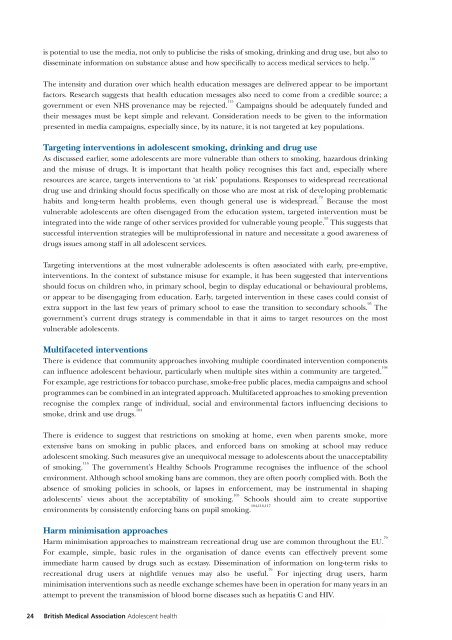Alcohol misuse: tackling the UK epidemic - London
Alcohol misuse: tackling the UK epidemic - London
Alcohol misuse: tackling the UK epidemic - London
Create successful ePaper yourself
Turn your PDF publications into a flip-book with our unique Google optimized e-Paper software.
24<br />
is potential to use <strong>the</strong> media, not only to publicise <strong>the</strong> risks of smoking, drinking and drug use, but also to<br />
disseminate information on substance abuse and how specifically to access medical services to help. 110<br />
The intensity and duration over which health education messages are delivered appear to be important<br />
factors. Research suggests that health education messages also need to come from a credible source; a<br />
government or even NHS provenance may be rejected. 115<br />
Campaigns should be adequately funded and<br />
<strong>the</strong>ir messages must be kept simple and relevant. Consideration needs to be given to <strong>the</strong> information<br />
presented in media campaigns, especially since, by its nature, it is not targeted at key populations.<br />
Targeting interventions in adolescent smoking, drinking and drug use<br />
As discussed earlier, some adolescents are more vulnerable than o<strong>the</strong>rs to smoking, hazardous drinking<br />
and <strong>the</strong> <strong>misuse</strong> of drugs. It is important that health policy recognises this fact and, especially where<br />
resources are scarce, targets interventions to ‘at risk’ populations. Responses to widespread recreational<br />
drug use and drinking should focus specifically on those who are most at risk of developing problematic<br />
habits and long-term health problems, even though general use is widespread. 79<br />
Because <strong>the</strong> most<br />
vulnerable adolescents are often disengaged from <strong>the</strong> education system, targeted intervention must be<br />
integrated into <strong>the</strong> wide range of o<strong>the</strong>r services provided for vulnerable young people. 93<br />
This suggests that<br />
successful intervention strategies will be multiprofessional in nature and necessitate a good awareness of<br />
drugs issues among staff in all adolescent services.<br />
Targeting interventions at <strong>the</strong> most vulnerable adolescents is often associated with early, pre-emptive,<br />
interventions. In <strong>the</strong> context of substance <strong>misuse</strong> for example, it has been suggested that interventions<br />
should focus on children who, in primary school, begin to display educational or behavioural problems,<br />
or appear to be disengaging from education. Early, targeted intervention in <strong>the</strong>se cases could consist of<br />
extra support in <strong>the</strong> last few years of primary school to ease <strong>the</strong> transition to secondary schools. 93<br />
The<br />
government’s current drugs strategy is commendable in that it aims to target resources on <strong>the</strong> most<br />
vulnerable adolescents.<br />
Multifaceted interventions<br />
There is evidence that community approaches involving multiple coordinated intervention components<br />
can influence adolescent behaviour, particularly when multiple sites within a community are targeted. 104<br />
For example, age restrictions for tobacco purchase, smoke-free public places, media campaigns and school<br />
programmes can be combined in an integrated approach. Multifaceted approaches to smoking prevention<br />
recognise <strong>the</strong> complex range of individual, social and environmental factors influencing decisions to<br />
smoke, drink and use drugs. 104<br />
There is evidence to suggest that restrictions on smoking at home, even when parents smoke, more<br />
extensive bans on smoking in public places, and enforced bans on smoking at school may reduce<br />
adolescent smoking. Such measures give an unequivocal message to adolescents about <strong>the</strong> unacceptability<br />
of smoking. 116<br />
The government’s Healthy Schools Programme recognises <strong>the</strong> influence of <strong>the</strong> school<br />
environment. Although school smoking bans are common, <strong>the</strong>y are often poorly complied with. Both <strong>the</strong><br />
absence of smoking policies in schools, or lapses in enforcement, may be instrumental in shaping<br />
adolescents’ views about <strong>the</strong> acceptability of smoking. 105<br />
Schools should aim to create supportive<br />
environments by consistently enforcing bans on pupil smoking. 104,116,117<br />
Harm minimisation approaches<br />
Harm minimisation approaches to mainstream recreational drug use are common throughout <strong>the</strong> EU. 79<br />
For example, simple, basic rules in <strong>the</strong> organisation of dance events can effectively prevent some<br />
immediate harm caused by drugs such as ecstasy. Dissemination of information on long-term risks to<br />
recreational drug users at nightlife venues may also be useful. 79<br />
For injecting drug users, harm<br />
minimisation interventions such as needle exchange schemes have been in operation for many years in an<br />
attempt to prevent <strong>the</strong> transmission of blood borne diseases such as hepatitis C and HIV.<br />
British Medical Association Adolescent health
















